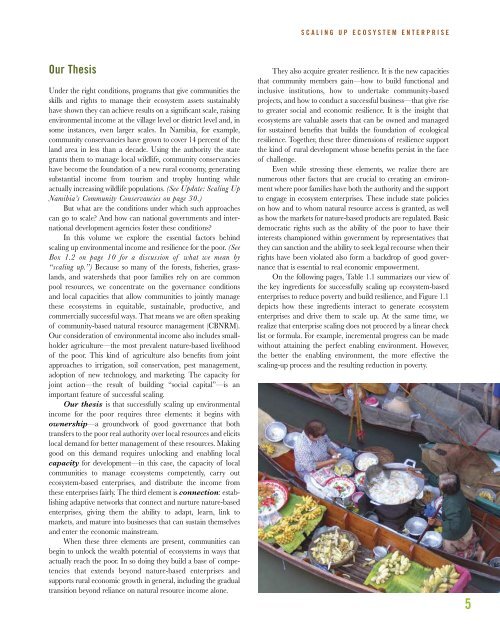Growing the Wealth of the Poor - World Resources Institute
Growing the Wealth of the Poor - World Resources Institute
Growing the Wealth of the Poor - World Resources Institute
Create successful ePaper yourself
Turn your PDF publications into a flip-book with our unique Google optimized e-Paper software.
S C A L I N G U P E C O S Y S T E M E N T E R P R I S EOur ThesisUnder <strong>the</strong> right conditions, programs that give communities <strong>the</strong>skills and rights to manage <strong>the</strong>ir ecosystem assets sustainablyhave shown <strong>the</strong>y can achieve results on a significant scale, raisingenvironmental income at <strong>the</strong> village level or district level and, insome instances, even larger scales. In Namibia, for example,community conservancies have grown to cover 14 percent <strong>of</strong> <strong>the</strong>land area in less than a decade. Using <strong>the</strong> authority <strong>the</strong> stategrants <strong>the</strong>m to manage local wildlife, community conservancieshave become <strong>the</strong> foundation <strong>of</strong> a new rural economy, generatingsubstantial income from tourism and trophy hunting whileactually increasing wildlife populations. (See Update: Scaling UpNamibia’s Community Conservancies on page 30.)But what are <strong>the</strong> conditions under which such approachescan go to scale? And how can national governments and internationaldevelopment agencies foster <strong>the</strong>se conditions?In this volume we explore <strong>the</strong> essential factors behindscaling up environmental income and resilience for <strong>the</strong> poor. (SeeBox 1.2 on page 10 for a discussion <strong>of</strong> what we mean by“scaling up.”) Because so many <strong>of</strong> <strong>the</strong> forests, fisheries, grasslands,and watersheds that poor families rely on are commonpool resources, we concentrate on <strong>the</strong> governance conditionsand local capacities that allow communities to jointly manage<strong>the</strong>se ecosystems in equitable, sustainable, productive, andcommercially successful ways. That means we are <strong>of</strong>ten speaking<strong>of</strong> community-based natural resource management (CBNRM).Our consideration <strong>of</strong> environmental income also includes smallholderagriculture—<strong>the</strong> most prevalent nature-based livelihood<strong>of</strong> <strong>the</strong> poor. This kind <strong>of</strong> agriculture also benefits from jointapproaches to irrigation, soil conservation, pest management,adoption <strong>of</strong> new technology, and marketing. The capacity forjoint action—<strong>the</strong> result <strong>of</strong> building “social capital”—is animportant feature <strong>of</strong> successful scaling.Our <strong>the</strong>sis is that successfully scaling up environmentalincome for <strong>the</strong> poor requires three elements: it begins withownership—a groundwork <strong>of</strong> good governance that bothtransfers to <strong>the</strong> poor real authority over local resources and elicitslocal demand for better management <strong>of</strong> <strong>the</strong>se resources. Makinggood on this demand requires unlocking and enabling localcapacity for development—in this case, <strong>the</strong> capacity <strong>of</strong> localcommunities to manage ecosystems competently, carry outecosystem-based enterprises, and distribute <strong>the</strong> income from<strong>the</strong>se enterprises fairly. The third element is connection: establishingadaptive networks that connect and nurture nature-basedenterprises, giving <strong>the</strong>m <strong>the</strong> ability to adapt, learn, link tomarkets, and mature into businesses that can sustain <strong>the</strong>mselvesand enter <strong>the</strong> economic mainstream.When <strong>the</strong>se three elements are present, communities canbegin to unlock <strong>the</strong> wealth potential <strong>of</strong> ecosystems in ways thatactually reach <strong>the</strong> poor. In so doing <strong>the</strong>y build a base <strong>of</strong> competenciesthat extends beyond nature-based enterprises andsupports rural economic growth in general, including <strong>the</strong> gradualtransition beyond reliance on natural resource income alone.They also acquire greater resilience. It is <strong>the</strong> new capacitiesthat community members gain—how to build functional andinclusive institutions, how to undertake community-basedprojects, and how to conduct a successful business—that give riseto greater social and economic resilience. It is <strong>the</strong> insight thatecosystems are valuable assets that can be owned and managedfor sustained benefits that builds <strong>the</strong> foundation <strong>of</strong> ecologicalresilience. Toge<strong>the</strong>r, <strong>the</strong>se three dimensions <strong>of</strong> resilience support<strong>the</strong> kind <strong>of</strong> rural development whose benefits persist in <strong>the</strong> face<strong>of</strong> challenge.Even while stressing <strong>the</strong>se elements, we realize <strong>the</strong>re arenumerous o<strong>the</strong>r factors that are crucial to creating an environmentwhere poor families have both <strong>the</strong> authority and <strong>the</strong> supportto engage in ecosystem enterprises. These include state policieson how and to whom natural resource access is granted, as wellas how <strong>the</strong> markets for nature-based products are regulated. Basicdemocratic rights such as <strong>the</strong> ability <strong>of</strong> <strong>the</strong> poor to have <strong>the</strong>irinterests championed within government by representatives that<strong>the</strong>y can sanction and <strong>the</strong> ability to seek legal recourse when <strong>the</strong>irrights have been violated also form a backdrop <strong>of</strong> good governancethat is essential to real economic empowerment.On <strong>the</strong> following pages, Table 1.1 summarizes our view <strong>of</strong><strong>the</strong> key ingredients for successfully scaling up ecosystem-basedenterprises to reduce poverty and build resilience, and Figure 1.1depicts how <strong>the</strong>se ingredients interact to generate ecosystementerprises and drive <strong>the</strong>m to scale up. At <strong>the</strong> same time, werealize that enterprise scaling does not proceed by a linear checklist or formula. For example, incremental progress can be madewithout attaining <strong>the</strong> perfect enabling environment. However,<strong>the</strong> better <strong>the</strong> enabling environment, <strong>the</strong> more effective <strong>the</strong>scaling-up process and <strong>the</strong> resulting reduction in poverty.5
















